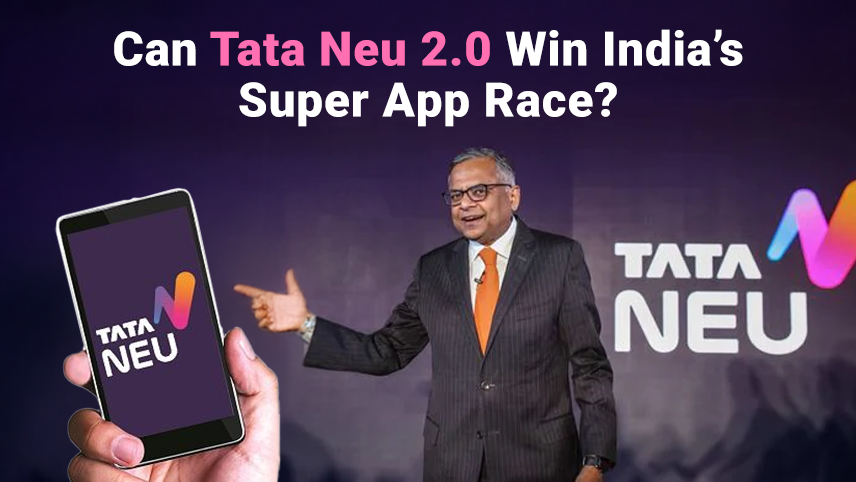
Can Tata Neu 2.0 Win India’s Super App Race?
Inside the Silent War for India’s Digital Future
Imagine one app that lets you order groceries, book flights, buy medicines, shop for gadgets, and even earn rewards, all in one place. No switching between ten different apps. No logging in again and again. Just one simple digital gateway to everything you need in a day. Sounds perfect, right?
That’s the dream of a super app, and the race to build it is heating up fast in India.
While giants like Jio, Flipkart, Amazon, and PhonePe are sprinting ahead, one powerful yet quiet contender is making a comeback, Tata. Backed by over 150 years of trust and business legacy, the Tata Group is betting big on its super app, Tata Neu. After a shaky first attempt, they've returned with Tata Neu 2.0, faster, smarter, and far more focused.
But can this new version really compete in India’s crowded digital ecosystem? Can it rise from an underwhelming debut and become the one app Indians truly rely on?
This blog takes you inside the story of Tata Neu’s journey, the setbacks, the silent rebuild, and the bold ambition to win the super app race. And by the end, you might just see why the future of digital India could have “Tata” written all over it.
The Super App Dream: Why Everyone Wants to Win This Race
India isn’t just a growing market anymore. This is where the next big fight for global digital power begins. Every few months, we hear about a new “super app” trying to capture India’s 1.4 billion hearts. From Reliance’s Jio platforms to Paytm, Amazon, PhonePe, Flipkart, and even foreign giants like Google, everyone’s in the race.
But the idea of a “super app” isn’t just about bundling services. It’s about owning your everyday habits, shopping, paying bills, watching movies, ordering groceries, booking cabs, buying medicine, and more, all inside one app. The winner of this race won’t just be another tech brand. It’ll become the default digital life of India.
And quietly, with less noise but deep pockets and deep connections, the Tata Group has entered the ring once again. But this time, with version 2.0 of their ambitious platform, Tata Neu.
Can Tata Neu 2.0 really become India’s go-to super app? Or is it just another corporate experiment in a crowded digital playground?
Let’s unpack this, step by step, story by story.
A Quiet Beginning, A Loud Expectation
When Tata rolled out Tata Neu in April 2022, it entered the market with massive expectations riding on its shoulders. This was no ordinary brand entering the market. This was the TATA Group, a 150-year-old legacy with businesses in steel, salt, software, and everything in between. They weren’t starting from scratch. They already owned popular platforms like BigBasket, 1mg, Croma, and AirAsia India. The plan was simply to connect the dots.
But something didn’t click. Users complained about slow app speeds. The UI felt confusing. The promised seamless experience, from booking flights to buying electronics, just wasn’t working smoothly. With all its promise, the super app ended up feeling more like a daily battle than a breakthrough.
Behind the scenes, though, Tata wasn’t giving up.
The Reinvention: What’s New in Tata Neu 2.0?
If version 1.0 was Tata testing the waters, then Tata Neu 2.0 is them diving in headfirst.
The revamp isn't just about design. It’s about experience. Neu 2.0 is faster, cleaner, and more focused on personalization. The clutter is gone. Now when you open the app, you're not bombarded with ten different tabs. You see what matters to you, whether that's groceries, flights, tech gadgets, or rewards.
The loyalty program, NeuCoins, has also been strengthened. Every transaction earns you coins that you can redeem across platforms. This isn’t new in concept. But Tata has something others don’t, trust and diversity. You can now use the NeuCoins you earn on 1mg to shop at Croma too. Groceries from BigBasket can give you discounts on AirAsia flights. It feels connected now. It feels intentional.
But here’s the real question: will this be enough?
India’s Digital User: Loyal, Yet Ruthless
The Indian digital consumer is unique. We're loyal, but only until the next best offer shows up. We love rewards, but not at the cost of convenience. And we’re brutally honest, if something doesn’t work, we uninstall without thinking twice.
That’s what happened with Tata Neu’s first launch. People expected magic. But what they got felt like a slow, clunky bundle of different apps stitched together. Some even said it felt more like a “browser inside an app” than a real super app.
But in India, second chances are not just given, they’re earned. And Tata has been putting in the work.
The Tata Trust Factor: Is It Their Secret Weapon?
Let’s pause for a moment and think about something that numbers can’t always show, trust.
How many apps do you use where you completely trust the brand behind it? Where you don’t worry about hidden costs, data misuse, or cheap marketing tricks?
That’s where Tata has an edge. For over a century, the Tata name has stood for values. Whether it’s Tata Steel or TCS, Titan or Tata Motors, people feel safe with the brand. And in the digital world, where scams, spam, and shady practices are everywhere, trust might just be the most powerful currency.
When a small-town entrepreneur in Gujarat orders electronics from Croma through Tata Neu, they aren’t just clicking a button. They’re trusting a name their grandfather respected. That’s the emotional connection Tata is quietly banking on.
But is trust enough in the era of speed and slick UX?
What Tata Neu 2.0 Still Has to Figure Out
Despite the upgrades, Tata Neu 2.0 still faces a few bumps on the road. The app is smoother now, but it’s still playing catch-up with digital-first giants. Players like Amazon and Flipkart have been improving their interfaces for over a decade. Paytm has created a complete digital ecosystem with payments at its core. PhonePe is partnering with every kirana store in India. Tata Neu, on the other hand, is still figuring out its identity.
Is it an e-commerce app? A travel platform? A pharmacy? A rewards wallet? Or all of the above?
Sometimes, trying to be everything for everyone can dilute the experience. Tata has to make sure that in connecting its vast empire, it doesn’t lose the one thing that matters most, focus.
Jio, Flipkart, PhonePe – The Rivals Aren’t Sleeping
While Tata is rebuilding, its rivals are accelerating. Jio Financial Services is planning to roll out its own bundled services, from telecom to e-commerce to banking. Flipkart is pushing Flipkart Pay Later. PhonePe is steadily stepping beyond payments, now making moves into mutual funds, insurance, and even travel bookings. PhonePe is steadily stepping beyond payments, now making moves into mutual funds, insurance, and even travel bookings.
Everyone wants the “super app” crown. And they’re moving fast.
But here’s where Tata's strategy is different. Instead of chasing every new trend, they’re integrating what they already own. Their play is long-term. While others build new verticals from scratch, Tata is simply stitching together businesses they’ve already acquired and mastered.
It’s not flashy. But it might just be smart.
Tata’s Ecosystem Edge: Why the Game Isn’t Over Yet
What does a true super app need? Just great features? No. It needs an ecosystem. Not just one big app, but many small experiences that flow together naturally.
And this is where Tata has a real shot.
Think about this: someone books an AirAsia flight on Tata Neu. They get NeuCoins. They use those to buy groceries on BigBasket. That earns them more NeuCoins, which they use to buy a smartwatch on Croma. Their medication gets delivered from 1mg the next morning.
All of this, inside one ecosystem. One login. One rewards currency. One interface. No spam. No guesswork.
It sounds small. One right idea can change everything and take your game to the next level.
The Emotional Angle: What Indians Truly Want
In the end, it’s not the features people connect with, it’s the feeling your brand gives them. They fall in love with feelings. People want convenience, yes. But they also want to feel smart, safe, and respected. If Tata Neu can deliver not just services, but a feeling, of being understood, of being taken care of, then it doesn’t need to shout to win. It just needs to quietly serve.
And in a market where everyone’s shouting, silence, powered by deep care, might just be the loudest signal.
So… Can Tata Neu 2.0 Win the Race?
The truth is, the race is still on. No one has won yet. Not even Jio.
But Tata Neu 2.0 is no longer just a bold experiment. It’s becoming a serious player. With better UX, tighter integration, and the emotional weight of the Tata brand, it’s slowly carving out its space.
Will it beat every rival overnight? No.
But will it become a trusted part of Indian digital life over time? If it plays its cards right, absolutely yes.
Because what India truly needs isn’t just another app, it needs a solution that actually makes life better. It needs a digital home. And who better to build a home, than the company that built trust brick by brick, for over a century?
Final Thought:
In the super app war, features may get attention, but feelings win loyalty. And Tata Neu 2.0, if it continues on this path, may just become the quiet winner India didn’t see coming, but will remember forever.
- Business Ideas
- Businessman
- Investment Ideas
- Business Case study






